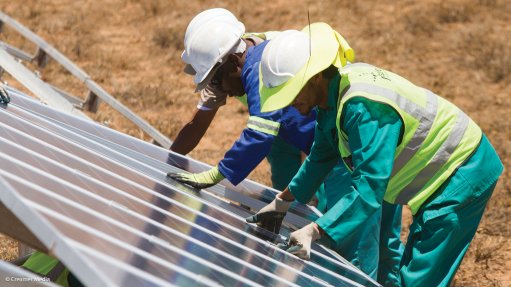DRMSA to map out next steps as trial nears end
As the spotlight remains on South Africa’s move from analogue to digital television broadcasting, a consortium has quietly gained some traction in shifting radio broadcasting to digital as a trial starts revealing the benefits.
The Digital Radio Mondiale Southern Africa (DRMSA) consortium, in partnership with Christian radio station Radio Pulpit, pioneered the first DRM trial in South Africa in an effort to fast-track local adoption of the high-quality, digital replacement for current analogue radio broadcasting in the AM and FM/VHF bands.
The steering committee of the Southern African branch of the global DRM consortium now planned to meet in Pretoria on October 23 to map out its next steps after the trial concluded in May 2015, but government support would be needed to enable the initiative to gain commercial traction and bolster the local manufacturing sector.
The DRMSA steering committee comprised TUB director Warren Muir, Radio Pulpit COO Karel Verhoef, Broadcom International CEO Chris Joubert and Ciskastreet director Kobus Boshoff.
South Africa’s DRM strategy was limited until the end of the trial, Radio Pulpit MD and DRMSA chairperson Dr Roelf Petersen said. However, he pointed out that, at a later stage, DRM would be expanded across the borders of South Africa into neighbouring States such as Mozambique, Botswana and Zambia.
Following the trial – and after obtaining a licence from the Independent Communications Authority of South Africa to permanently broadcast on the DRM standard – Radio Pulpit would start the one-year migration of its listeners to the new platform.
The DRMSA aimed to stimulate the introduction and roll-out of DRM broadcasts on the back of the limited dependability of existing AM services and the saturated FM sound broadcasting bands.
DRM enabled “significant improvements” in the reliability and audio quality of radio broadcasts.
DRM global consortium marketing director Radu Obreja said the International Telecommunications Union had endorsed DRM for worldwide deployment and, currently, there were over 100 DRM services worldwide, covering nearly 50% of the world’s population.
Following the global trend towards the adoption of digital technology, including that of television broadcasting and radio and communications, Brazil, India and Germany, besides others, had already launched their own local national consortiums to roll out, or strategise, the deployment of DRM.
The DRM radio broadcasting standard comprised two modes, namely DRM30, which was mainly used for large-area and international coverage and intended for AM broadcasts on short, medium and long wave up to 30 MHz, and the DRM+, which served the spectrum above 30 MHz and included the VHF band III for local and regional coverage.
The DRMSA-led trial, which started in July, was based on a DRM30 configuration designed to operate alongside AM broadcast frequency bands, using Radio Pulpit’s 25 kW DRM-ready transmitter and a 24 m low-profile antenna, based in Kameeldrift, Pretoria, to broadcast 10 kW on a medium wave AM 1 440 kHz frequency.
These results would be compared with Radio Pulpit’s 657 kHz 50 kW analogue transmission from a 300-m-high mast in Meyerton, south of Johannesburg.
Radio Pulpit aimed to evaluate coverage data against planning data, review groundwave, skywave and fading zones, analyse DRM audio and value-added services, register receiver behaviour, obtain listeners’ feedback and evaluate alternative low-profile antennas.
The correlation of data and the test report of the four-phase trial would be released in June, said Joubert.
However, the advantages of a complementary digital broadcast system below 30 MHz (DRM30) were already clear to Radio Pulpit and, together with the DRMSA consortium, the radio station aimed to lead the way for South Africa’s adoption of the standard.
The initial results emerging from the trial not only showed significant improvements in the audio quality of speech and music, but also reduced energy consumption from between 70 kW and 80 kW to between 18 kW and 20 kW.
DRM, which was compatible with the DAB standard and analogue transmissions, delivered FM-like, or CD-like, sound quality and enabled the automatic tune-in by station name, with uninterrupted, auto-adjusting high-quality reception, regardless of regional or national boundary crossings.
The digital standard, which would enable the broadcast of three to four channels on one frequency and could be operated with the same channelling and spectrum allocations as currently employed, could be used for a range of audio content and boasted the capacity to integrate text and data.
It would also enable the broadcast of emergency warnings and electronic programme guides.
Further, there would be distant-learning advantages through the transmission of data and text, as well as medical management through the distribution of information to remote clinics and rural communities.
As well as offering advanced audio quality and enhanced experiences for listeners, the adoption of DRM could be beneficial to broadcasters, the DRMSA consortium agreed.
The standard could significantly reduce the initial investment cost for a broadcaster, allowing a phased-in approach to the changeover from analogue to digital broadcasting and spreading the required investment over a period of time.
The use of DRM also increased broadcasters’ opportunities for revenue generation streams and allowed for multilingual programming and the relay of extra information, while reducing power consumption by up to 50% and allowing more capacity on fewer frequencies.
DRMSA also planned to demonstrate a business case for locally producing and selling DRM radio sets or auxiliary devices.
As with the digital terrestrial television (DTT) migration, the roll-out of digital radio could open up manufacturing potential and present an opportunity for local manufacturers to increase the market potential and possibilities for new areas of interest and content.
This was especially so as 93% of South Africa’s 14.5-million households, representing about 37-million people, listened to the radio – outstripping the reach of television, which only covered about 20-million people, said Boshoff.
Muir believed the local manufacture of the components required for the DRM receivers, which would start with about 45% local content in the first year, could create between 300 and 400 direct jobs, and in excess of 1 000 support jobs in the peripheral fields of sales, logistics and distribution and services, besides others.
However, government funding and support would be needed to gain manufacturing momentum and create an industry capable of supporting global demand for DRM receivers.
Petersen said that an in-depth study had indicated that local manufacture was feasible as South Africa boasted the capability, capacity and the market to locally manufacture the units required for the transition.
There were at least six large-scale manufacturers and several small operators with the capability and capacity to locally produce or assemble the required digital receivers for digital radio, Boshoff pointed out.
He called on government to express similar commitment to the radio digital migration as it did for DTT, for which the State forked out billions of rands to accelerate.
Government support would also be needed in the regulatory space, as well as with subsidies related tothe transmission costs of small regional radio stations, besides others.
Comments
Press Office
Announcements
What's On
Subscribe to improve your user experience...
Option 1 (equivalent of R125 a month):
Receive a weekly copy of Creamer Media's Engineering News & Mining Weekly magazine
(print copy for those in South Africa and e-magazine for those outside of South Africa)
Receive daily email newsletters
Access to full search results
Access archive of magazine back copies
Access to Projects in Progress
Access to ONE Research Report of your choice in PDF format
Option 2 (equivalent of R375 a month):
All benefits from Option 1
PLUS
Access to Creamer Media's Research Channel Africa for ALL Research Reports, in PDF format, on various industrial and mining sectors
including Electricity; Water; Energy Transition; Hydrogen; Roads, Rail and Ports; Coal; Gold; Platinum; Battery Metals; etc.
Already a subscriber?
Forgotten your password?
Receive weekly copy of Creamer Media's Engineering News & Mining Weekly magazine (print copy for those in South Africa and e-magazine for those outside of South Africa)
➕
Recieve daily email newsletters
➕
Access to full search results
➕
Access archive of magazine back copies
➕
Access to Projects in Progress
➕
Access to ONE Research Report of your choice in PDF format
RESEARCH CHANNEL AFRICA
R4500 (equivalent of R375 a month)
SUBSCRIBEAll benefits from Option 1
➕
Access to Creamer Media's Research Channel Africa for ALL Research Reports on various industrial and mining sectors, in PDF format, including on:
Electricity
➕
Water
➕
Energy Transition
➕
Hydrogen
➕
Roads, Rail and Ports
➕
Coal
➕
Gold
➕
Platinum
➕
Battery Metals
➕
etc.
Receive all benefits from Option 1 or Option 2 delivered to numerous people at your company
➕
Multiple User names and Passwords for simultaneous log-ins
➕
Intranet integration access to all in your organisation


















